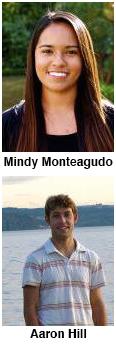Event Date:
Event Location:
- Webb Hall 1100
Minda Monteagudo and Aaron Hill, both UCSB Earth Science graduate students, will each give a talk at this week's Speakers Club. Minda's talk is entitled A study of modern planktonic foraminifera: refining our understanding of paleoceanographic tools and Aaron's talk is entitled Saturated hydraulic conductivity in Mission Creek, Maria Ygnasio Creek, and San Jose Creek, Santa Barbara, Southern California. Speakers Club meets at 2:00 PM on Thursday in Webb Hall 1100.
Minda's abstract:
Climate sensitivity—the temperature increase associated with doubling atmospheric CO2 – is a critical parameter for projecting future climate scenarios but remains poor- ly constrained by model-based estimates. CO2 measurements and temperature recon- structions over the last 800,000 years provide the means to refine our understanding of climate sensitivity. Quantitative reconstructions of past temperature rely on proxies such as foraminifera. Thus, precise temperature proxies are necessary for narrowing down the wide range of climate sensitivity estimates. A key assumption of foramin- ifera-based reconstructions is that the proxy represents mean annual thermal condi- tions. Using highly resolved sediment trap samples from the Hawaii Ocean Time-Se- ries, we test this assumption by evaluating seasonal and inter-annual flux variability. Foraminifera at this site exhibit higher flux during summer months, consistent with long-term biological observations. Our results suggest that foraminifera-derived tem- peratures from the Central Tropical Pacific reflect summer, not mean annual, condi- tions. Additionally, these findings may offer a solution for previous studies that in- dicate warming in the Central Tropical Pacific during the Last Glacial Maximum (Waelbroeck et al., 2009), despite low atmospheric CO2 and global temperatures.
Aaron's abstract:
This project aims to study the variability in hydraulic conductivity and grain size amongst differing stream morphology, (riffles, pools, bars and floodplains). I use a single ring infiltrometer to calculate the rate of infiltration of water into the streambed sediments for each morphology. Sediment samples are collected from each measurement location, and sieved into 15 different bins in order to determine the grain-size distribution. Thus far, results indicate that: 1) riffles have a higher Kfs than pools, 2) pools exhibit the most variability in Kfs, 3) floodplains have the lowest infiltration rate and 4) the d10 grain-size constituent has the highest coefficient of determination R^2 (0.83) with hydraulic conductivity.

